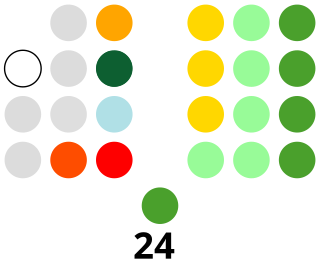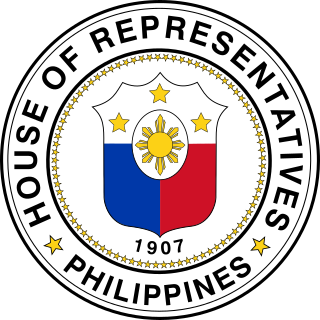The House of Representatives of the Philippines is the lower house of Congress. The House of Representatives has existed from 1945 to 1972, and since 1987. Whenever a bicameral system is used, a lower house has existed under the name of the Philippine Assembly from 1907 to 1934. When a unicameral system is in use, the sole house of the legislature has been called as the National Assembly from 1935 to 1941 (the Commonwealth National Assembly) and from 1943 to 1944 (the Second Republic National Assembly). When a parliament is in use, they were all in a unicameral setup and were known as the Malolos Congress during the 19th century, and the Batasang Pambansa from 1978 to 1986. All of their members are noted here.

A congress is a formal meeting of the representatives of different countries, constituent states, organizations, trade unions, political parties, or other groups. The term originated in Late Middle English to denote an encounter during battle, from the Latin congressus.

A senate is a deliberative assembly, often the upper house or chamber of a bicameral legislature. The name comes from the ancient Roman Senate, so-called as an assembly of the senior and therefore considered wiser and more experienced members of the society or ruling class. However the Roman Senate was not the ancestor or predecessor of modern parliamentarism in any sense, because the Roman senate was not a de jure legislative body.
Unicameralism is a type of legislature consisting of one house or assembly that legislates and votes as one. Unicameralism has become an increasingly common type of legislature, making up nearly 60% of all national legislatures and an even greater share of subnational legislatures.

The Congress of the Philippines is the legislature of the national government of the Philippines. It is bicameral, composed of an upper body, the Senate, and a lower body, the House of Representatives, although colloquially, the term "Congress" commonly refers to just the latter. The Senate meets at the GSIS Building in Pasay, while the House of Representatives meets at the Batasang Pambansa in Quezon City, which also hosts joint sessions.

The House of Representatives of the Philippines is the lower house of Congress, the bicameral legislature of the Philippines, with the Senate of the Philippines as the upper house. The lower house is commonly referred to as Congress, although the term collectively refers to both houses.

The Senate of the Philippines is the upper house of Congress, the bicameral legislature of the Philippines, with the House of Representatives as the lower house. The Senate is composed of 24 senators who are elected at-large under a plurality-at-large voting system.
The chamber of deputies is the lower house in many bicameral legislatures and the sole house in some unicameral legislatures.

The government of the Philippines has three interdependent branches: the legislative, executive, and judicial branches. The Philippines is governed as a unitary state under a presidential representative and democratic constitutional republic in which the president functions as both the head of state and the head of government of the country within a pluriform multi-party system.
The legislative districts of Abra are the representations of the province of Abra in the various national legislatures of the Philippines. The province is currently represented in the lower house of the Congress of the Philippines through its lone congressional district.
The legislative districts of Antipolo are the representations of the component city of Antipolo in the Congress of the Philippines. The city is currently represented in the lower house of Congress through its first and second congressional districts.
The legislative districts of Aklan are the representations of the province of Aklan in the various national legislatures of the Philippines. The province is currently represented in the lower house of the Congress of the Philippines through its first and second congressional districts.
The legislative districts of Agusan del Sur are the representations of the province of Agusan del Sur in the various national legislatures of the Philippines. The province is currently represented in the lower house of the Congress of the Philippines through its first and second congressional districts.
The legislative districts of Aurora are the representations of the province of Aurora in the various national legislatures of the Philippines. The province is currently represented in the lower house of the Congress of the Philippines through its lone congressional district.
The legislative districts of Apayao are the representations of the province of Apayao in the various national legislatures of the Philippines. The province is currently represented in the lower house of the Congress of the Philippines through its lone congressional district.
The legislative districts of Albay are the representations of the province of Albay in the various national legislatures of the Philippines. The province is currently represented in the lower house of the Congress of the Philippines through its first and second, and third congressional districts.
The legislative districts of Antique are the representations of the province of Antique in the various national legislatures of the Philippines. The province is currently represented in the lower house of the Congress of the Philippines through its lone congressional district.
The legislative districts of the Philippines are the divisions of the Philippines' provinces and cities for representation in the various legislative bodies. Congressional districts are for House of Representatives, while there are districts for Sangguniang Panlalawigan, and some Sangguniang Panlungsod. For purposes of representation, the Senate, most Sangguniang Panlungsod, Sangguniang Bayan, Sangguniang Barangay and Sangguniang Kabataan are all elected at-large, although there were districts for the Senate from 1916 to 1935.

The senatorial districts of the Philippines were the representations of the provinces of the Philippines in the Philippine Senate from 1916 to 1935.
The Constitution of the Philippines is the constitution or the supreme law of the Republic of the Philippines. Its final draft was completed by the Constitutional Commission on October 12, 1986, and ratified by a nationwide plebiscite on February 2, 1987.